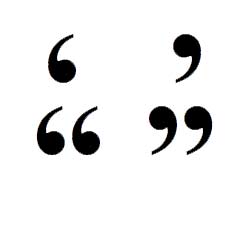 People are very quotable. I personally enjoy quoting myriad books, movies, and random videos from the Internet. But when you need to note that you’re quoting something or someone, there are little punctuation marks that you can use.
People are very quotable. I personally enjoy quoting myriad books, movies, and random videos from the Internet. But when you need to note that you’re quoting something or someone, there are little punctuation marks that you can use.
The humble quotation mark was first used in the mid-1500’s with the advent of the printing press. They first came into popular use during the 1700’s, when they symbolized pithy remarks, a function that they have retained to this day in the form of ‘airquotes’.
But how do you use a quotation mark? This one isn’t as complicated as the comma or the apostrophe. Simply put, put quotation marks around anything that you want to say exactly as they said it. While that sounds confusing, it’s fairly simple. Let’s say Ann and Bob are having a conversation. Let’s say Bob proclaims his love for live oysters Later that day, Ann is writing an e-mail to Carly and Ann wants to tell her what Bob said. If Ann directly quotes Bob, she needs quotation marks, like so: Bob said, “I love live oysters.” However, if Ann can’t remember what exactly Bob said, she can paraphrase him. If you paraphrase, you cannot use quotation marks. For example: Did you hear about Bob’s love of live oysters?
There are more rules for quotation marks (aren’t there always?). One common use is to note that the word being used in the context of the sentence is non-standard. This applies for puns, slang, or any use of a word that is not completely correct. Another rule is that the titles of short stories need to be in quotation marks, as do the titles of book chapters.
That’s most of the rules that you should ever need for the quotation mark. What’s our advice? Have someone else read it over to see if you’ve done it right. We do proofread all of our signs, but you have the final say. If there’s ambiguity, we defer to you.
